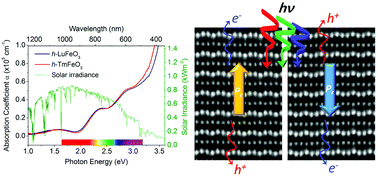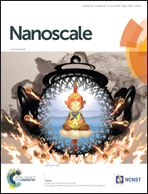Switchable ferroelectric photovoltaic effects in epitaxial h-RFeO3 thin films†
Abstract
Ferroelectric photovoltaics (FPVs) have drawn much attention owing to their high stability, environmental safety, and anomalously high photovoltages, coupled with reversibly switchable photovoltaic responses. However, FPVs suffer from extremely low photocurrents, which is primarily due to their wide band gaps. Here, we present a new class of FPVs by demonstrating switchable ferroelectric photovoltaic effects and narrow band-gap properties using hexagonal ferrite (h-RFeO3) thin films, where R denotes rare-earth ions. FPVs with narrow band gaps suggest their potential applicability as photovoltaic and optoelectronic devices. The h-RFeO3 films further exhibit reasonably large ferroelectric polarizations (4.7–8.5 μC cm−2), which possibly reduces a rapid recombination rate of the photo-generated electron–hole pairs. The power conversion efficiency (PCE) of h-RFeO3 thin-film devices is sensitive to the magnitude of polarization. In the case of the h-TmFeO3 (h-TFO) thin film, the measured PCE is twice as large as that of the BiFeO3 thin film, a prototypic FPV. The effect of electrical fatigue on FPV responses has been further investigated. This work thus demonstrates a new class of FPVs towards high-efficiency solar cell and optoelectronic applications.



 Please wait while we load your content...
Please wait while we load your content...